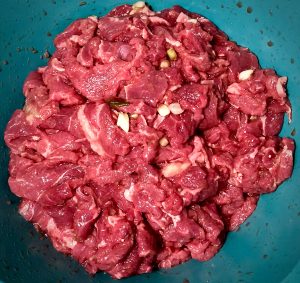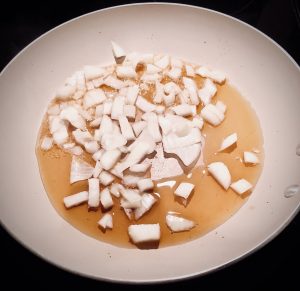Bulgogi is the kind of staple that you might expect to find at a Korean BBQ place, or on someone’s kitchen table. The main star of bulgogi is the garlic, a common ingredient in many Korean dishes. Bulgogi also shows how the ingredients available in a locale can give rise to culinary innovation—the Asian pear in bulgogi contains an enzyme that breaks down the meat, making it more tender. Bulgogi is a versatile dish that can be altered to fit different dietary needs. Because the main element of bulgogi is the marinade, you can substitute beef for chicken, or meat for a vegetarian substitute like tofu. Bulgogi is also pretty easy to prepare. You marinate it overnight and the next day you can cook it whenever you’re ready to eat. Bulgogi is a versatile dish that shows the constantly evolving, dynamic nature of Korean cuisine.
The starting point of my bulgogi journey actually started on another journey: while I was on vacation with my family, we stopped by Burger Seoul, a small food truck in Tacoma that specializes in Korean fusion food. One of their burgers was the bulgogiger, a fun twist on the classic. It consisted of bulgogi sandwiched between two buns and fresh, crunchy lettuce, dripping with a savory, complex sauce. But once I’d had their spin on bulgogi, I wanted to try the inspiration, the dish behind the dish.
My next stop was assembling my A-Team; getting the ingredients. But that brought up another question: to substitute, or not to substitute? Bulgogi, as I’ve said, is a very versatile dish, and a lot of the ingredients can be substituted for others. For my first few trial runs, I opted to go with what was easiest to source. This decision found me at Target, reaching for an ingredient I had never used before: kiwi fruit. This is the easiest substitute for Asian pears, because it has the enzyme needed to tenderize the meat, and doesn’t really have much of its own flavor. Kiwi serves as the bottom of the cheer pyramid in bulgogi. It isn’t the star, but if it wasn’t there everything would collapse. The rest of the ingredients were pretty common, and I found them easily.
Finally, I was ready. The first part of preparing bulgogi is easy. I put soy sauce, leek, garlic, brown sugar, and grated kiwi in a large bowl. Kiwi is a very soft fruit, so grating it is easy. It pretty much falls apart. Then, I took the sliced sirloin and cut it up further to make sure the cuts of meat weren’t too large. There wasn’t a particular science behind it; I just wanted to make sure the meat absorbed the marinade well and wasn’t unwieldy when cooking. Next, I put on kitchen-safe disposable gloves and mixed the meat into the marinade by hand. This is the easiest way to evenly distribute the marinade through the meat. When the marinade has thoroughly saturated the meat, there should be no excess when you tip the bowl slightly. Once this is done, I let the meat marinate in the fridge overnight. In the morning, I cooked it in a large pan with canola oil until it was well done.
I was delighted with the results. Bulgogi didn’t have very many steps, and none of them were too labor intensive. But in my bulgogi quest, I had an unanswered question. Did the substitution of traditional ingredients for ones I could more easily find make a difference in the dish? Was it less authentic?
To answer my question, I made my way to Mr. Chen’s, the local Asian food store. Mr. Chen’s is a kind of wonder land, where you can find everything from sweet jasmine rice to squid. The first time I went, they didn’t have the elusive ingredient I lacked: the Asian pear. But their fruits and vegetables do change, and if you can’t find what you’re looking for one day, it’s worth it to take a second look. I grabbed two of the pale golden pears and made my way to the cash register (along with some less necessary items, like a cute cat bowl and matching plate).
The prep for the bulgogi didn’t change much, except for the pear. Pears are much sturdier than kiwis, and grating it took a little more effort. If easiness is your main factor in deciding what ingredient to use, I would definitely advise that you opt for the kiwi. Although the cooking didn’t change much, I found that the flavor profile of the bulgogi had changed more than I had initially expected. The pear had given it a subtle sweetness that the less flavorful kiwi had lacked, and it was more nuanced than when the garlic had taken a definitive center stage.
So was this the answer, I wondered? Was this the authentic bulgogi? Ultimately, I don’t think so.
Authenticity is hard to nail down when it comes to food. Food is always changing, and that spirit of innovation which is so prominent in Korean cuisine means that one person’s idea of authenticity is very different from another’s, especially in a rapidly globalizing food scene. In the end, I think it’s only possible to be authentic to your own food—whether that’s using the ingredient that’s easier to find, or going a little farther to get the familiar taste of home.
- First, prepare the marinade: add soy sauce, leek (you can substitute green onions) garlic, brown sugar, and grated Asian pear to a bowl. If you have a local Asian food store, you should be able to find it there. If not, you can substitute for a kiwi, which also contains the enzyme needed to break down and tenderize the meat. If you do substitute kiwi, don’t worry if you can’t keep the incredibly tiny seeds out of the marinade. This is fine. They’re perfectly edible.

- Next, slice the sirloin to your desired size. I slice mine fairly small in order to make sure it absorbs the marinade and cooks quickly.
- Mix the sirloin into the marinade thoroughly using hands. When it has absorbed the marinade properly, you can tip the bowl—if no liquid seeps out, it’s ready.

- Put the bulgogi into the fridge overnight.
- When the bulgogi is done, slice the onions and put them in a pan with oil. I like to use sesame oil; the taste goes well with Korean foods.

- Cook the bulgogi until it’s well done, and plate as desired. I like to plate mine with the bulgogi on lettuce, in the ssam, or wrap, that it’s usually eaten in, with ssamjang on the side.